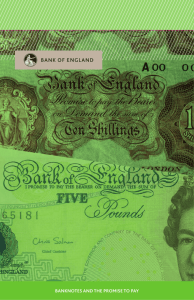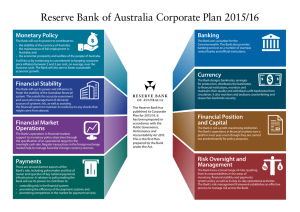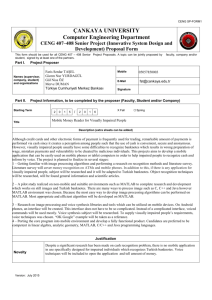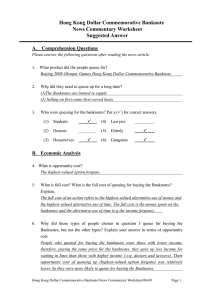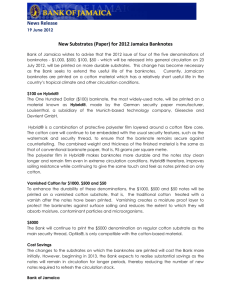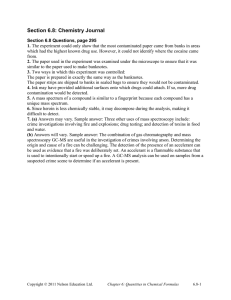file6
advertisement
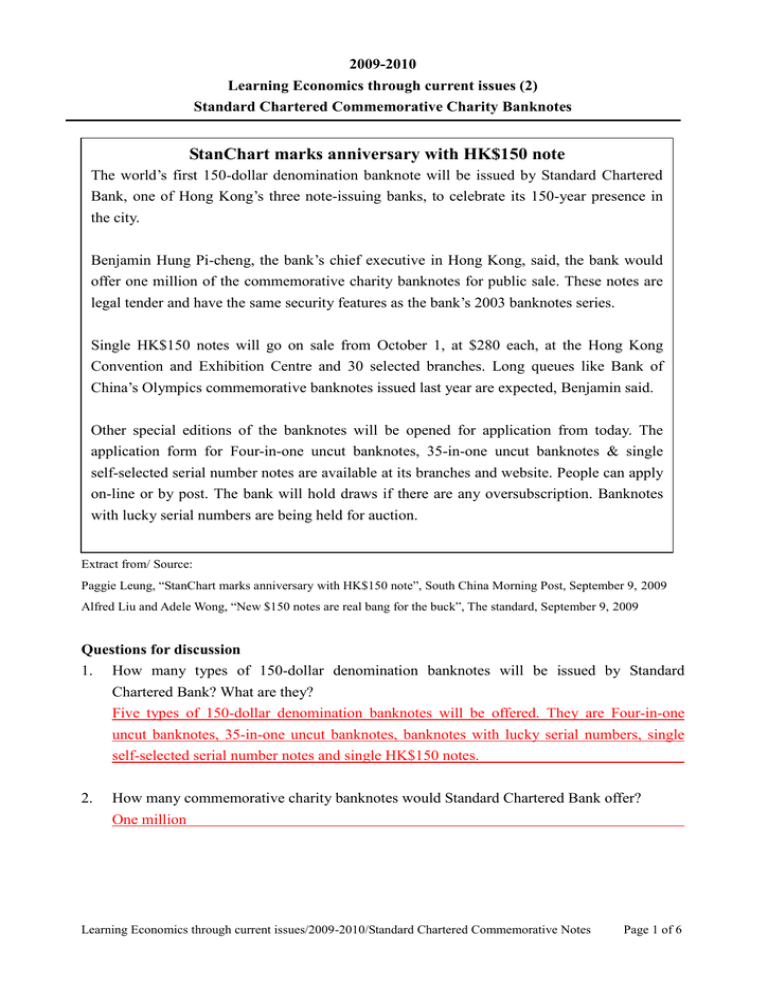
2009-2010 Learning Economics through current issues (2) Standard Chartered Commemorative Charity Banknotes StanChart marks anniversary with HK$150 note The world’s first 150-dollar denomination banknote will be issued by Standard Chartered Bank, one of Hong Kong’s three note-issuing banks, to celebrate its 150-year presence in the city. Benjamin Hung Pi-cheng, the bank’s chief executive in Hong Kong, said, the bank would offer one million of the commemorative charity banknotes for public sale. These notes are legal tender and have the same security features as the bank’s 2003 banknotes series. Single HK$150 notes will go on sale from October 1, at $280 each, at the Hong Kong Convention and Exhibition Centre and 30 selected branches. Long queues like Bank of China’s Olympics commemorative banknotes issued last year are expected, Benjamin said. Other special editions of the banknotes will be opened for application from today. The application form for Four-in-one uncut banknotes, 35-in-one uncut banknotes & single self-selected serial number notes are available at its branches and website. People can apply on-line or by post. The bank will hold draws if there are any oversubscription. Banknotes with lucky serial numbers are being held for auction. Extract from/ Source: Paggie Leung, “StanChart marks anniversary with HK$150 note”, South China Morning Post, September 9, 2009 Alfred Liu and Adele Wong, “New $150 notes are real bang for the buck”, The standard, September 9, 2009 Questions for discussion 1. How many types of 150-dollar denomination banknotes will be issued by Standard Chartered Bank? What are they? Five types of 150-dollar denomination banknotes will be offered. They are Four-in-one uncut banknotes, 35-in-one uncut banknotes, banknotes with lucky serial numbers, single self-selected serial number notes and single HK$150 notes. 2. How many commemorative charity banknotes would Standard Chartered Bank offer? One million Learning Economics through current issues/2009-2010/Standard Chartered Commemorative Notes Page 1 of 6 3. Please indicate the methods of subscription for different editions of the banknotes respectively. Single HK$150 notes: on first-come-first-served basis “Four-in-one uncut banknotes”, “35-in-one uncut banknotes” and “Single self-selected serial number” notes: on-line application or by post. The bank will hold draws if there are any oversubscriptions. Banknotes with lucky serial numbers: public bidding 4. Which of the above application methods can be classified as price competition? Which of them are kinds of non-price competition? Price competition: Auction (bidding) Non-price competition: first-come-first-served basis, by draws 5. What are the explicit cost and implicit cost of queueing up for buying the single notes? Explicit cost: The price of the banknotes, i.e. $280 Implicit cost: The highest-valued alternative use of time in queueing for the notes (e.g. the income forgone). 6. According to Benjamin Hung Pi-cheng, why long queues lining up to buy commemorative banknotes are expected? What economic term can be used to describe his expectation? Since it is the world’s first HK$ 150 banknotes, many people queuing up for buying the notes is expected. It is estimated that the quantity demanded of the notes is greater than the quantity supplied, thus long queues are expected. In economics, this relates to the problem of shortage. 7. Explain, with the aid of a supply and demand diagram, why the situation mentioned in Q.6 would happen. It is the first ever $150 banknotes in the P S world, and the bank will only offer one million banknotes for pubic sale. If the market price of the notes sets below the P0 equilibrium price (P0), the quantity demanded of the notes will be greater than the quantity supplied, shortage will then arise. This explains why Benjamin expected that there will be long queues lining up to buy the notes. 8. P1 0 Q0 Q1 D SQ Commemorative banknotes If the problem mentioned in Q.6 really happens, how can it be solved? Increase the price to the equilibrium level (P0). Print more notes to meet the excess demand. Learning Economics through current issues/2009-2010/Standard Chartered Commemorative Notes Page 2 of 6 9. Suppose the problem of shortage really happened, and some people ask the bank to offer more commemorative banknotes to meet the excess demand. If you were the director of Standard Chartered Bank, will you adopt this idea? Explain. Free answers. P If the bank offers more banknotes: S If the bank offers more banknotes to meet the quantity demanded, i.e., Q1, the total revenue of the bank will increase from area 0P1AQ0 to area 0P1BQ1. If the bank doesn’t offer more banknotes: With imperfect information, it will be costly S0 S1 P0 P1 0 A B Q0 Q1 D S Q 0 Commemorative banknotes for the bank to know the exact quantity 渣打紀念鈔票 demanded for the notes. Moreover, if the bank overestimates the quantity demanded of the notes, i.e. offer the notes beyond Q1, surplus will arise and there will be a pressure to lower the price. Besides, it can also be a commercial decision not to offer more notes to maintain the storage value of them. 10. Will you use the commemorative note for shopping? Why? As the cost of using the banknote (storage/resale value) is higher than its face value, people will not spend with it for shopping. 11. With reference to Q.10, which function of money can the commemorative notes best perform? Store of value. Learning Economics through current issues/2009-2010/Standard Chartered Commemorative Notes Page 3 of 6 Extended Part Do you remember in July 2008, Bank of China sold its Olympic notes? Please read the following news article carefully and answer the questions. Banknote rush hits a sour note Hundreds of people queued outside Bank of China branches last night to buy commemorative banknotes bearing the Olympic logo, which go on sale tomorrow. Some of them had been waiting for more than 30 hours. Those in the queues include elderly, housewives and young people. They brought along with umbrellas, mats, plastic chairs and newspapers for the long wait. The bank will issue four million commemorative banknotes with a picture of a plinth, the Beijing 2008 logo, the Bank of China tower in Hong Kong and the image of the Beijing Olympic Games stadium (the “Birds Nest”). The selling price of the five packages ranges from HK$138 to HK$1,388. People need to queue for the tickets, entitling the holders to buy, before they can make the purchase. Each person will be limited to purchase one set of each type per visit. An elderly, who was first in line at the King’s Road branch, suggested that there should be a better system like issuing tickets, so that they don’t have to wait in the street for two days, especially for the elderly. Extracted from / Source: Diana Lee, “Banknote rush hits a sour note”, The Standards, July 15, 2008. 12. How many packages of Olympic Banknotes did Bank of China (BOC) offer? 5 packages 13. How did people buy the Olympic banknotes? People had to queue for the tickets, entitling the holders to buy the note package, before they could make the purchase. 14. Compare with Standard Chartered Bank, can you figure out the difference of the subscription methods between the two banks? Queuing was the only way to get Olympic banknotes offered by Bank of China, people had to queue for the entitling tickets before they bought the notes. Standard Chartered Bank used a range of methods, from queuing up to online booking and bidding. Learning Economics through current issues/2009-2010/Standard Chartered Commemorative Notes Page 4 of 6 15. Which bank, Standard Chartered or Bank of China, provided a more flexible arrangement? Why? Free answers Compared with single method offered by Bank of China, Standard Chartered Bank allowed more flexibility to the public. 16. Two banks provided different subscription methods. Who would prefer the arrangement of Bank of China? Who would prefer the arrangement of Standard Chartered Bank? Please discuss from economic perspective. Free Answers People who have high cost of queuing up would prefer the arrangement of Standard Chartered Bank. Offering various methods for applying for the notes can greatly reduce the waiting cost. For those non-internet users, they would welcome the policy adopted by Bank of China. Since their cost for seeking help from others or learning how to use the internet is much higher than the waiting cost, thus, they prefer BOC’s practice. If the cost of queuing up is very low (i.e. their value of the highest-valued alternative use of time is pretty low), they are indifferent to the methods of these two banks. 17. How many note-issuing banks are there in Hong Kong? Which are they? Three. They are BOC, Standard Chartered Bank and Hongkong and Shanghai banking Corporation (HSBC) 18. If one of the note-issuing banks decides to issue “Sixty Years of The People’s Republic of China Commemorative Banknotes”. Can you give it some advice on the application methods? Explain your answer from the economic perspective. Free answers Report: (1) Compare and contrast the application methods, sales (Any long queues? Appropriate selling arrangement? Any chaotic situation?) and resale situation of commemorative banknotes between BOC and Standard Chartered Bank from economic perspective. Students also can give their opinions or preference and give reasons. (2) Examine those application methods adopted by Standard Chartered Bank and Bank of China, which method do you think is the most appropriate? Please explain from economic perspective. Students can explain from different dimensions, e.g. in terms of cost-effectiveness, the amount of deadweight loss etc. Learning Economics through current issues/2009-2010/Standard Chartered Commemorative Notes Page 5 of 6 Proposal: (3) If one of the note-issuing banks decides to issue “Sixty Years of The People’s Republic of China Commemorative Banknotes”, prepare a report to the bank to discuss, from economic perspective, what it should pay attention to for the application methods. Learning Economics through current issues/2009-2010/Standard Chartered Commemorative Notes Page 6 of 6
